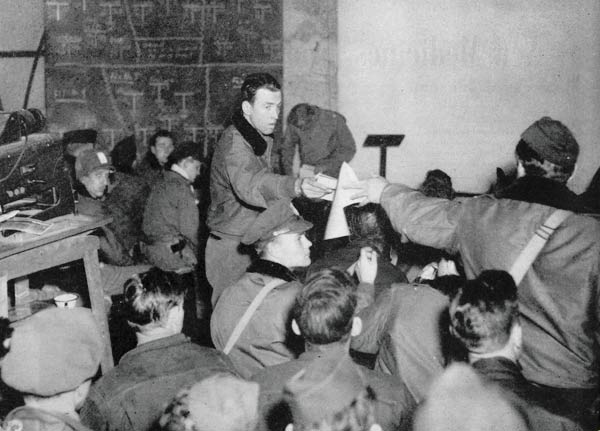No movie is more closely associated with the Christmas season than It’s a Wonderful Life. For many people, it is the essential holiday movie, and the role they most closely associate with Jimmy Stewart.
In many ways, Stewart was very much like the character of George Bailey—the congenial, folksy manager of the Bailey Building and Loan Association. But there was far more depth to the actor than his movie roles suggested, as Post readers learned in December 1945. “Jimmy Stewart’s Finest Performance,” written by Colonel Beirne Lay Jr., showed a side of the actor that had been largely kept out of the press: Colonel James Stewart of the 445th Bomber Group.
Despite being overage and underweight, Stewart was able to enlist in the U.S. Army Air Corps in 1941 on the strength of his flying experience. He’d received his pilot’s license in 1935, and already had 400 hours of flying time by the beginning of the war.
The armed forces were glad to sign up celebrities. Young men were encouraged to enlist when they saw famous musicians and movie stars in uniform. But the military was careful to keep the big names away from the shooting. A celebrity killed in action might discourage potential recruits. So movies stars, like Robert Taylor, Henry Fonda, and Mickey Rooney, served in uniform but saw little, if any, combat.
Clark Gable was one of the few exceptions. After enlisting in the Air Force, and completing the training, he served as a gunner on missions over Germany in a B-17.
The odds were against Stewart ever seeing combat. He was a particularly valuable property, having just won the Oscar for Best Actor after his performance in The Philadelphia Story. But Stewart was determined to fly in combat, and continued his training throughout 1942. It was only when the rest of his training unit shipped to Europe and he remained as a trainer-pilot in Boise, Idaho, that he realized the truth.

Fortunately, he was able to get his commander to intercede and get him a commission with a bomber group flying B-24s. In October 1943, his unit arrived at its airfield in Norfolk, England. Over the next year, he flew 20 missions into Germany, dodging intense anti-aircraft fire and Luftwaffe fighter planes in the most intense, and costly, air combat ever seen.
According to several accounts, Stewart wasn’t just a good pilot. He was exceptional. The Air Corps, recognizing his flying skill and ability to command, gave him the lead in several of the 1,500-plane raids into Germany. He helped plan the bombing missions and often conducted the briefings for pilots, where he would use his skills as a performer to liven up the sessions and keep the aviators’ attention. Walter Matthau, then a sergeant with the squadron, would sit through Stewart’s briefing because they were so entertaining.
He was also careful and meticulous. He would sit through briefings twice to make sure he had heard all the details.

But he wasn’t immune to the fears. Colonel Low knew how the pressure mounted on the pilot-actor with each mission. Stewart began suffering from recurring nightmares, and his digestion was so upset he often lived on just ice cream and peanut butter.
He admitted to Low that, in February 1944, he was convinced he would die in the next day’s bombing run. But he took off anyway, fought his way deep into Germany and returned, bringing himself and his crew unharmed back to the base.
He returned to Hollywood in the spring of 1945. The first acting job he accepted was the role of George Bailey—a nice, idealistic guy who selflessly puts his life on hold while he takes care of others.
You might gain a new appreciation for Stewart’s acting talent the next time you watch It’s a Wonderful Life and remember, one year earlier, he was flying through fierce anti-aircraft fire and seeing his comrades shot out of the sky. Yet he still seems the boyish character he’d always played. You can’t even tell how his hair had been tinted to cover all the gray he’d picked up since The Philadelphia Story.
Read more about Stewart’s military experiences in “Jimmy Stewart’s Finest Performance” from the Post archive.
Become a Saturday Evening Post member and enjoy unlimited access. Subscribe now




